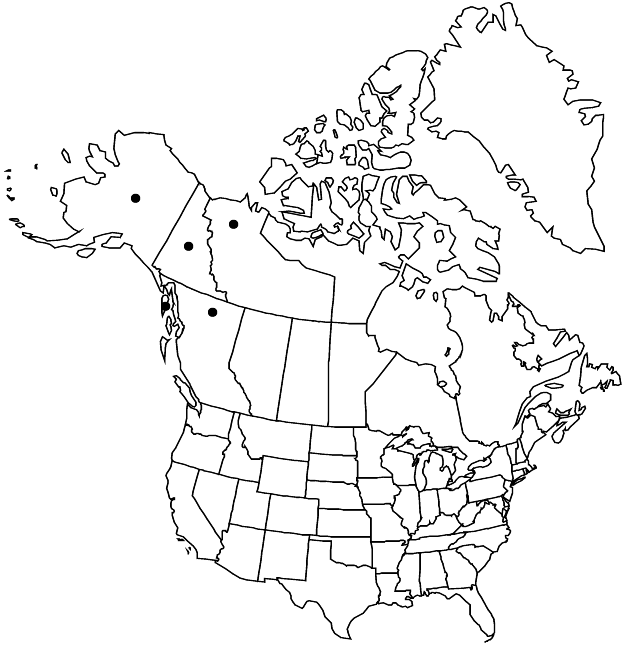Difference between revisions of "Minuartia macrocarpa"
Meddel. Grønland 37: 226. 1920.
FNA>Volume Importer |
FNA>Volume Importer |
||
| Line 15: | Line 15: | ||
|name=Alsinopsis macrocarpa | |name=Alsinopsis macrocarpa | ||
|authority=(Pursh) A. Heller | |authority=(Pursh) A. Heller | ||
| − | }}{{Treatment/ID/Synonym | + | }} {{Treatment/ID/Synonym |
|name=Wierzbickia macrocarpa | |name=Wierzbickia macrocarpa | ||
|authority=(Pursh) Reichenbach | |authority=(Pursh) Reichenbach | ||
| Line 33: | Line 33: | ||
|elevation=0-2200 m | |elevation=0-2200 m | ||
|distribution=B.C.;N.W.T.;Yukon;Alaska;Asia (Japan;Russian Far East;Siberia). | |distribution=B.C.;N.W.T.;Yukon;Alaska;Asia (Japan;Russian Far East;Siberia). | ||
| − | |discussion=<p>An amphi-Beringian species, Minaurtia macrocarpa is easily distinguished by having the largest capsules of any North American Minuartia.</p> | + | |discussion=<p>An amphi-Beringian species, Minaurtia macrocarpa is easily distinguished by having the largest capsules of any North American <i>Minuartia</i>.</p> |
|tables= | |tables= | ||
|references= | |references= | ||
| Line 57: | Line 57: | ||
|publication year=1920 | |publication year=1920 | ||
|special status= | |special status= | ||
| − | |source xml=https://jpend@bitbucket.org/aafc-mbb/fna-data-curation.git/src/ | + | |source xml=https://jpend@bitbucket.org/aafc-mbb/fna-data-curation.git/src/8f726806613d60c220dc4493de13607dd3150896/coarse_grained_fna_xml/V5/V5_260.xml |
|subfamily=Caryophyllaceae subfam. Alsinoideae | |subfamily=Caryophyllaceae subfam. Alsinoideae | ||
|genus=Minuartia | |genus=Minuartia | ||
Revision as of 17:37, 18 September 2019
Plants perennial, mat-forming. Taproots stout, woody. Stems erect to ascending, green, 3–10 cm, glabrous or sometimes stipitate-glandular, internodes of flowering stems 1–5 times as long as leaves. Leaves tightly overlapping (vegetative), variably spaced (cauline), usually connate proximally, with tight, scarious to herbaceous sheath 1–1.5 mm; blade straight to outwardly curved, green, flat, 3-veined, often prominently so abaxially, linear to oblong or narrowly lanceolate, 4–14 × 0.5–2 mm, flexuous, margins thickened, ± coriaceous, ciliate, often densely so, apex green, rounded, navicular, shiny, glabrous or essentially so throughout or abaxially, sometimes pubescent adaxially, hairs resembling cilia; axillary leaves present among vegetative leaves. Inflorescences solitary flowers, terminal; bracts linear, herbaceous. Pedicels 0.4–1 cm, usually densely stipitate-glandular. Flowers: hypanthium cup-shaped; sepals prominently 3-veined proximally, lanceolate to oblong (herbaceous portion often purple, lanceolate to oblong), 4.5–6 mm, to 9 mm in fruit, apex often purple, rounded, hooded, stipitate-glandular; petals broadly obovate, 1.2–1.6 times as long as sepals, apex blunt or rounded, entire. Capsules narrowly ellipsoid, 10–18 mm, longer than sepals. Seeds red-brown to brown, orbiculate with radicle prominent and notch filled with papillae, somewhat compressed, 1–1.1 mm (excluding papillae), rounded-tuberculate, ringed with longitudinal, cylindrical, tan papillae 0.5–0.8 mm. 2n = 44 (Russia), 46, 48 (Russia).
Phenology: Flowering spring–summer.
Habitat: Rocky, montane ridges, sandy slopes, well-drained alpine tundra and heathlands
Elevation: 0-2200 m
Distribution

B.C., N.W.T., Yukon, Alaska, Asia (Japan, Russian Far East, Siberia).
Discussion
An amphi-Beringian species, Minaurtia macrocarpa is easily distinguished by having the largest capsules of any North American Minuartia.
Selected References
None.